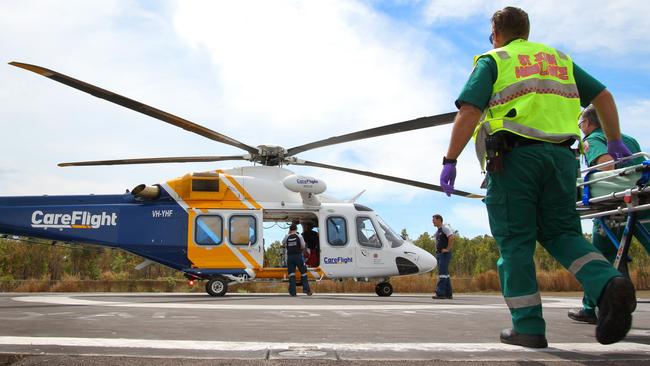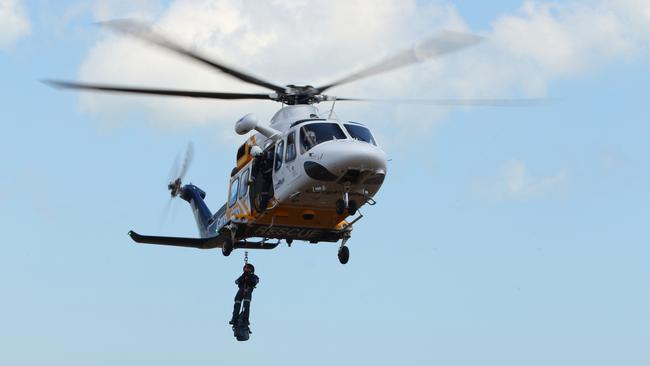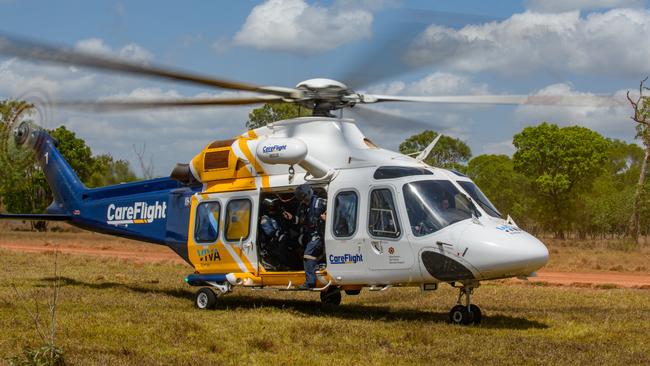CareFlight NT: 10-year anniversary of the AW139, the bird that’s saved thousands of lives
Ten years ago, CareFlight, the NT’s aeromedical rescue helicopter provider, realised it needed a serious machine to cater for our remote and rugged climes, so it gave us the AW139. This is the chopper’s story.

Northern Territory
Don't miss out on the headlines from Northern Territory. Followed categories will be added to My News.
Ten years ago, CareFlight, the Territory’s aeromedical rescue helicopter provider, realised it needed a serious machine to cater for our remote and rugged climes.
So, in 2014, it sent the Leonardo AW139, a beast of a bird that was specifically designed for aeromedical missions in remote and challenging environments and markets for an eight-figure sum.
It was an astute investment: in the 10 years of its operation, it has flown more than 1500 missions and saved countless Territorians from untimely ends.
To mark the occasion, CareFlight, the national aeromedical service that entered the Territory in 2007, wants the AW139s story told.
In the early years, CareFlight provided services on a case-by-case basis, flying dozens of medical evacuations and search and rescue operations on behalf of the NT government and Australian Maritime Safety Authority.
By 2013, CareFlight was providing the Top End Medical Retrieval Service on behalf of the NT government.

The service operated the highly capable BK117 helicopter, an aircraft proven in CareFlight’s NSW operations and trusted by many aeromedical operations worldwide.
The BK117s were customised and equipped to operate in northern Australia’s remote and rugged terrain environments.
However, with demand for the service increasing, and the unique operational challenges and demands posed by the Territory’s unforgiving landscape, it was clear that a bigger helicopter with the ability to travel vast ranges and carry more people and equipment would have greater lifesaving capabilities.

So, with the financial support of Territorians, an AW139, the most trusted model in global aeromedical helicopter operations, entered operations, replacing the respected but fading BK117.
Most attractively, it had a range that blew the BK117 out of the water, and a cabin so spacious that it could carry both rescue equipment and inter-hospital equipment without having to reconfigure for each mission, saving significant time.
And with an average of one mission flown every two to three days – and sometimes multiple missions on a single day – not needing to reconfigure was a luxury.
A former chief pilot for CareFlight, Richard Sandford, initially flew the AW139 NT rescue helicopter, and today continues to fly fixed-wing aircraft for the service.
“CareFlight’s staff underwent extensive training both in Australia and internationally to ensure the highest standards of safety and efficiency,” Mr Sandford said.
“The introduction of the AW139 has been a game-changer for our operations.
“Its advanced capabilities have allowed us to reach more patients in need, faster and more efficiently.”
Mr Sandford said the aircraft has excelled over 10 years to overcome the challenges of extreme weather, vast distances, and the complexities of remote rescues.
“Every mission presents unique challenges requiring strategic thinking and innovative solutions to ensure timely and effective responses.,” he said.

Over the coming months, CareFlight will host a series of events, share stories of breathtaking rescues, and open up about what the next decade might hold for the vital service.
“Many patients’ lives have been saved by this helicopter over its 10 years in service,” general manager northern operations Jodie Mills said.
“As we look ahead to our next 10 years, CareFlight’s crews remain dedicated to continuously finding ways to save more lives and achieve better patient outcomes.”





